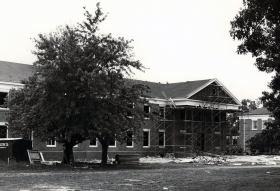Now part of the School of Communications, the Iris Holt McEwen Building once served as the home of Elon’s library.

Enter the first floor of the Iris Holt McEwen Building today and you’ll find student journalists working in the newly christened Paul Parsons Student Newsroom. You’ll see state-of-the-art studios and a large wall dedicated to student and alumni awards. Up until 18 years ago, however, this space was the first floor of the Iris Holt McEwen Library.
By the 1960s, Elon College was quickly outgrowing its humble library in Carlton. Construction of a new library began in 1966, following a groundbreaking ceremony that took place on Parents’ Day that fall. After more than a year and a half of construction, the library was completed in the summer of 1968. With the new building finished, the challenge remained of moving the university’s entire collection of books from the existing library in Carlton.

The new library opened the very next day. The building’s three floors offered enough space for 600 students to study, a much-needed upgrade from the old library’s reading room that could accommodate only 100 students. The library also had the capacity to hold 120,000 books, strategically planned for the college to continue growing its collection. Patrons of the library could enjoy the building’s air conditioning, a luxury that had not been available in Carlton. Featuring the latest modern technology, the library also housed 24 listening tables for vinyl records and cassette tapes, as well as microfilm and microfiche readers. In addition, the library had an art exhibit space and a “Church History” room.

In the summer of 1995, McEwen Library underwent a renovation. According to an article published in the Burlington Times-News, seldom-used books were moved off-site to accommodate new books. The technical services department, responsible for purchasing and cataloging new library materials, was also moved off-site to Arts West. In addition, shorter shelves replaced the seven-foot-tall bookshelves on the first floor, allowing visitors a clear view of the library. But this renovation was only a temporary fix. The school had once again outgrown its library, and planning began for a new space. The result was the Carol Grotnes Belk Library, which opened in 2000. After the library moved out of McEwen, the building was renovated to become the home of the new School of Communications.


